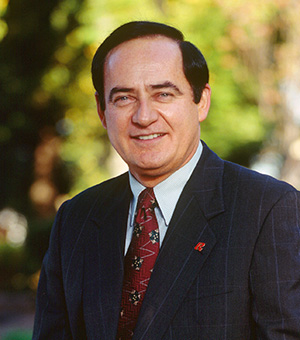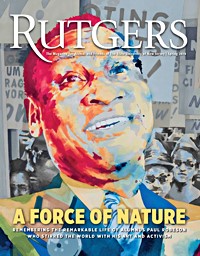Francis L. Lawrence
Rutgers President, 1990 to 2002

Those years were a time of sustained growth and achievement, and Lawrence, a nationally recognized educator who arrived at Rutgers from Tulane University, shepherded Rutgers through a focus on strategic planning, academic excellence, diversity initiatives, active fundraising, and major building programs.
A native of Rhode Island, Lawrence received his bachelor’s degree in French and Spanish from St. Louis University in 1959 and his Ph.D. in French Classical Literature from Tulane in 1962. He rose through Tulane’s academic and administrative ranks to full professor and chief academic officer. Lawrence was a devoted educator, and he saw the need for Rutgers to seek a balance between research and teaching.
“We must remember and give new life to the model of the scholar teacher,” he said in his inaugural address, noting it would be necessary “not to spend less of our funds and ourselves on research, but to increase the importance and the money that we devote to teaching both undergraduates and graduates.”
At the time Lawrence became president in 1990, the university was achieving notable recognition as a major public research university, having been invited to join the prestigious academic institutions making up the Association of American Universities in 1989. Lawrence saw strategic planning as a necessity for an institution of Rutgers’ complexity and prominence. Shortly after arriving at Rutgers, he helped shape a universitywide strategic planning process to identify Rutgers’ academic strengths, tie them to fiscal resources, and leverage external support. Following 100 planning studies by academic units, a universitywide plan, A New Vision for Excellence, identified 12 broad areas of particular strength, including cognitive science and neuroscience, liberal arts and sciences, and public policy and law, among others. These academic growth areas went on to serve as a springboard to foster excellence and to advance Rutgers into the top ranks of American public research universities.
In the years after the plan’s approval in 1995, the university added 25 new undergraduate and 28 new graduate degree programs and established more than 45 new research centers and institutes, including the W.M. Keck Center for Collaborative Neuroscience, Alan M. Voorhees Transportation Center, Allen and Joan Bildner Center for the Study of Jewish Life, John J. Heldrich Center for Workforce Development, Joseph C. Cornwall Center for Metropolitan Studies, and Walter Rand Institute for Public Affairs. These programs and centers would go on to have a lasting impact on the citizens of New Jersey, the nation, and beyond.
By every measure, Rutgers today is a better and stronger institution than ever before, one that is more respected and appreciated, more visible, and more involved as an agent of positive change.
Francis L. Lawrence, 2002
Technology was transforming the world, and Lawrence guided resources to areas such as web-based learning and computerized “smart” classrooms. One hallmark achievement was the implementation of RUNet 2000, a universitywide communications infrastructure project to support instruction, research, and outreach programming. Approved in 1998, the project was the largest infrastructure project in the university’s history, bringing voice, video, and data connections to hundreds of university buildings.
Under Lawrence, progress was made in myriad aspects of university life. Learning Resource Centers for undergraduates were opened on all Rutgers campuses beginning in 1992. Construction expanded facilities across the university: the Sonny Werblin Recreation Center gave the Busch Campus a first-class athletic facility in 1991; the Campus Center at Rutgers–Camden was expanded to include a new bookstore and health center in 1993, while the Camden Campus’s libraries were expanded in 1994; Rutgers–New Brunswick got a new football stadium in 1994; a renovated and expanded Dana Library at Rutgers–Newark allowed the Institute of Jazz Studies to make its collection available to students and scholars in 1994; the Civic Square Building, housing the Mason Gross School of the Arts and the Edward J. Bloustein School of Planning and Public Policy, opened in 1996 and expanded Rutgers’ presence in downtown New Brunswick; and a new Center for Law and Justice at Rutgers–Newark was dedicated in 1999. Meanwhile, minority enrollment grew by 41 percent between 1991 and 2001, with the Newark Campus ranking as the nation’s most diverse in a national magazine. And Rutgers’ involvement in college athletics advanced under Lawrence, as the university secured a participating membership in the Big East Conference.
Many of the strides can be attributed to a vigorous fundraising effort under Lawrence’s guidance. He spearheaded a reorganization of the Rutgers University Foundation, the university’s fundraising arm, resulting in an increase of nearly 500 percent in yearly giving to the university. By the end of the 2001–2002 academic year, $426 million had been raised in a major fundraising campaign, Creating the Future Today, with a $500 million goal. “By every measure, Rutgers today is a better and stronger institution than ever before, one that is more respected and appreciated, more visible, and more involved as an agent of positive change,” Lawrence said in addressing a Rutgers campaign gala in 2002.
Known nationally as an advocate for lifelong learning, Lawrence served on the Kellogg Commission on the Future of State and Land-Grant Universities. He chaired the commission subcommittee that produced a report, “Returning to Our Roots: A Learning Society,” recommending that public universities make lifelong learning a part of their core mission. “It is clear that there is a national consensus among opinion leaders that new kinds of alliances and partnerships will be necessary to reach our goals as a learning society,” Lawrence said at the time.
Lawrence announced his plan to return to the faculty in early 2002. In a letter to the university community, Lawrence said he wanted to step down at a point “when, thanks to the talent and hard work of everyone in the Rutgers community, our well-loved university has marked the achievement of a long list of historic benchmarks.” He served as University Professor and was the author of Leadership in Higher Education: Views from the Presidency, a collection of interviews with presidents and chancellors of leading universities.

